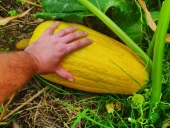
 5
5




 5
5




Our inability to change everything should not stop us from changing what we can.
 4
4




Nothing ruins a neighborhood like paved roads and water lines.
 4
4




 4
4




 6
6




 6
6




'What we do now echoes in eternity.' Marcus Aurelius
How Permies Works Dr. Redhawk's Epic Soil Series








 5
5




'What we do now echoes in eternity.' Marcus Aurelius
How Permies Works Dr. Redhawk's Epic Soil Series
 6
6




Lewis Steward wrote:
I am trying to do the same thing for Corn but there's such little open pollinated varieties in the UK... There's plenty of F1s to choose from... I don't suppose that would be a bad thing to use F1s to build a grex or will they be sterile??
How jealous I am of all the amazing corn varieties you have in the US

 8
8




 6
6




Thom Bri wrote:
Lewis Steward wrote:
I am trying to do the same thing for Corn but there's such little open pollinated varieties in the UK... There's plenty of F1s to choose from... I don't suppose that would be a bad thing to use F1s to build a grex or will they be sterile??
How jealous I am of all the amazing corn varieties you have in the US
Sounds like you have a great start for your squash project. Next year let us know how it's going.
As for corn, that's my hobby.
Corn sterility is rare enough you shouldn't even think about it. If it occurs you won't even notice because the other corn around it will do the job. F1s F2s etc. are fine.
What kind of corn is your goal? Sweet corn to eat as a vegetable, or field corn for making cornmeal to eat yourself, or animal food?
 4
4




Joseph Lofthouse wrote:In decades of growing different species of squash, close together, I have only found one naturally occurring inter-species squash hybrid among maxima-pepo-moschata. In theory, a maxima/moschata hybrid might occur infrequently.
Mixta and moschata seem to me to not quite be separate species, so I find hybrids between them fairly regularly.
I don't expect poisons to show up in your squash, unless you grow decorative gourds.

 5
5




 3
3




Christopher Weeks wrote:Lewis, I did exactly the same thing! I jumped into landracing while I was such a newbie gardener that I didn't realize the three big squash species wouldn't cross up well. I thought the difference was winter vs summer squash. (Which is also not any kind of reasonable distinction because you can eat young winter squash like zucchini/courgette and let those summer squash grow giant and cure for storage!) Here's the mix I started with:
Candystick Dessert Delicata C pepo
Sweet Meat - Oregon Homestead C maxima
Spaghetti Squash C pepo
Galeaux d'Eysines C maxima
Potimarron C maxima
Musquee De Marog C moschata
Giant Show King C maxima
Guatemalan Green-Fleshed Ayote C moschata
Nanticoke C maxima
Sweet Dumpling C pepo
Hessel Sugar Loaf C pepo
Oregon Homestead Sweet Meat C maxima
Marina di Chioggia C maxima
North Circle Butternut C moschata
Bigger Better Butternut C moschata
898 Experimental C moschata
Canada Crookneck C moschata
Lakota C maxima
Hopi Pale Grey C maxima
North Morning Moon C maxima
Vermillion River C maxima
Theron's Winter C maxima
Sweet Meat C maxima
Best of Buttercup C maxima
America C moschata
Gete-Okosomin C maxima
Borchart's Wonder C maxima
Gueramon Martinique C moschata
Arnie's Golden Buttercup C maxima
Emerald Naked Seeded Pumpkin C pepo
Lofthouse Buttercup C maxima
Ukrainian Squash C maxima
I've also used Joseph's squash ID doc to start sorting things out, but it's very incomplete and I'm still growing squash. I'll eat whatever I get and save seeds from what keeps and what I like.










 5
5




Lewis Steward wrote:Have there been many crosses amongst squash that you can identify?

 7
7




Lewis Steward wrote:Never heard of Mixta before... I take it's common in North America?
 4
4




Joseph Lofthouse wrote:
Lewis Steward wrote:Never heard of Mixta before... I take it's common in North America?
Mixta is also called cushaw, or argyrosperma. It is rare in the usa. I find the flavor disgusting. It was originally grown for seeds, but now we have the hulless pepo squash seeds, so mixta fell out of favor even more.

 3
3




Thom Bri wrote:Learn something new every time I visit. .... My knowledge is quite narrow.
How Permies works: https://permies.com/wiki/34193/permies-works-links-threads
My projects on Skye: The tree field, Growing and landracing, perennial polycultures, "Don't dream it - be it! "
 3
3




 2
2




Nancy Reading wrote:
Thom Bri wrote:Learn something new every time I visit. .... My knowledge is quite narrow.
My problem with my root crops was failing to keep the varieties separate at first - one swede looks pretty much like another, so deciding which ones to grow on for seed was tricky.
landrace seed saving: Swede/Rutabaga: https://permies.com/t/229808/Growing-Seed-saving-Neeps-rutabaga, Carrots: https://permies.com/t/263707/Landrace-Carrots
 2
2




Thom Bri wrote:Are you able to order seeds from Canada or Europe? Northern Europe has some interesting corn, descended from the northern corns originally imported back in the colonial era. I have recently been reading a lot of very interesting research into early northern varieties in the Polish scientific literature, for example.

| I agree. Here's the link: https://woodheat.net |




